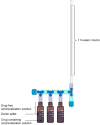In vitro studies on the dependence of drug deposition in dentin on drug concentration, contact time, and the physicochemical properties of the drugs
- PMID: 37587384
- PMCID: PMC10474980
- DOI: 10.1007/s00204-023-03573-6
In vitro studies on the dependence of drug deposition in dentin on drug concentration, contact time, and the physicochemical properties of the drugs
Abstract
The chemical analysis of dental hard tissues can provide information on previous drug use due to the deposition of drugs into this tissue. For the interpretation of analytical results in, e.g., postmortem toxicology or regarding archeological samples, the influence of drug dosing, consumption frequency, duration of intake and type of drug on analyte concentrations in teeth has to be characterized. To approximate these correlations, in vitro models were applied to investigate the time dependency of drug deposition via and against pulp pressure (perfusion studies) and the concentration dependency of drug deposition via oral cavity (incubation study) as well as the influence of de- and remineralization (pH cycling) on the incorporation of drugs in bovine dentin pellets. Some of the drugs of abuse most relevant in forensic case work (amphetamines, opiates, cocaine and benzoylecgonine) were applied. Concentrations in dentin samples were analyzed by liquid chromatography-tandem mass spectrometry (LC-MS/MS) after pulverization and extraction via ultrasonication with methanol. The studies showed that drug deposition in dentin likely depends on the physicochemical properties of the drug molecules as well as on the duration of contact with drugs via the blood stream and on drug concentrations present in the oral cavity. Higher drug concentrations in teeth can result from a more frequent or longer drug use. In addition, intake of higher doses or oral/inhalative consumption can also be expected to lead to higher drug concentrations. These findings can be helpful for the interpretation of postmortem cases.
Keywords: Alternative matrices; Dental hard tissues; Forensic toxicology; Illicit drugs; LC–MS/MS; Teeth.
© 2023. The Author(s).
Conflict of interest statement
The authors declare that they have no conflict of interest.
Figures



Similar articles
-
Determination of drugs of abuse in bovine dentin using liquid chromatography-electrospray ionization tandem mass spectrometry.J Mass Spectrom. 2014 Dec;49(12):1306-13. doi: 10.1002/jms.3464. J Mass Spectrom. 2014. PMID: 25476949
-
A pilot study on post-mortem determination of drug abuse on dental tissues.Forensic Sci Int. 2024 Oct;363:112185. doi: 10.1016/j.forsciint.2024.112185. Epub 2024 Aug 5. Forensic Sci Int. 2024. PMID: 39151241
-
Full validation of a method for the determination of drugs of abuse in non-mineralized dental biofilm using liquid chromatography-tandem mass spectrometry and application to postmortem samples.Talanta. 2018 Jan 1;176:360-366. doi: 10.1016/j.talanta.2017.08.047. Epub 2017 Aug 15. Talanta. 2018. PMID: 28917762
-
[Clinical and analytical toxicology of opiate, cocaine and amphetamine].Ann Biol Clin (Paris). 2015 Jan-Feb;73(1):54-69. doi: 10.1684/abc.2014.1009. Ann Biol Clin (Paris). 2015. PMID: 25582723 Review. French.
-
Role of liquid chromatography-high-resolution mass spectrometry (LC-HR/MS) in clinical toxicology.Clin Toxicol (Phila). 2012 Sep;50(8):733-42. doi: 10.3109/15563650.2012.713108. Epub 2012 Aug 13. Clin Toxicol (Phila). 2012. PMID: 22888997 Review.
Cited by
-
Unraveling Nanomaterials in Biomimetic Mineralization of Dental Hard Tissue: Focusing on Advantages, Mechanisms, and Prospects.Adv Sci (Weinh). 2024 Oct;11(40):e2405763. doi: 10.1002/advs.202405763. Epub 2024 Aug 29. Adv Sci (Weinh). 2024. PMID: 39206945 Free PMC article. Review.
References
-
- Altenburger MJ, Haller J, Holm J, Heumann C, Hellwig E (2012) The effect of a single fluoride gel application on carious lesions under severe cariogenic conditions. In: 9th ORCA congress, June 27–30, 2012, pp 322, Caries Res, Cabo Frio, Brazil
-
- Barbakow F. In vivo reactions on enamel surfaces after fluoride application. Dtsch Zahnarztl Z. 1983;38(Suppl 1):S23–26. - PubMed
-
- Cattaneo C, Gigli F, Lodi F, Grandi M. The detection of morphine and codeine in human teeth: an aid in the identification and study of human skeletal remains. J Forensic Odontostomatol. 2003;21:1–5. - PubMed
MeSH terms
Grants and funding
LinkOut - more resources
Full Text Sources

